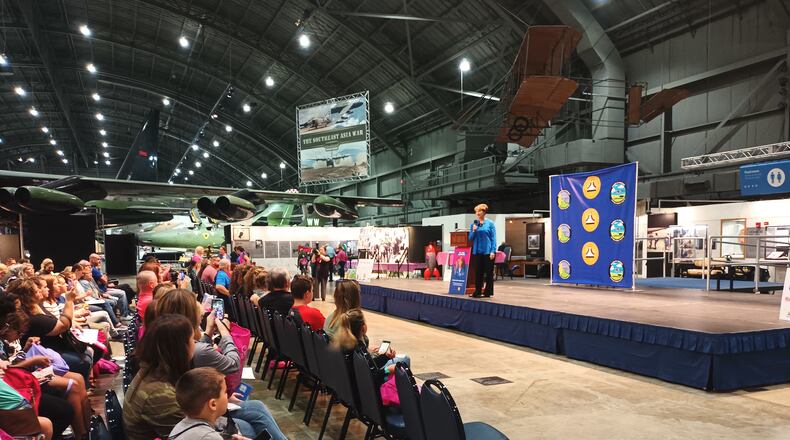It was organized in partnership between the Huffman Prairie and Wright chapters of Women in Aviation International, along with the National Aviation Hall of Fame and the National Museum of the U.S. Air Force.
Girls in Aviation Day was targeted toward girls between the ages of eight and 17, although boys were also welcome to join, organizers said. The event was held to bolster interest in flight along with the fields of science, technology, engineering and mathematics (STEM), particularly as the aviation workforce is seeing a demand for pilots and support personnel.
“We are extremely short in the pipeline to supply our aviation careers,” Ringer said. “Everything from pilots to mechanics to engineers, (air traffic control), it’s all short, and we haven’t developed that pipeline properly.”
“Our goal is to make girls aware of the opportunities in aviation and to get them excited and see themselves in all different jobs in aviation,” said Amy Spowart, president and CEO of the National Aviation Hall of Fame. “The aviation workforce is woefully underrepresented by females and minorities.”
Aerospace company Boeing predicts a need for 2.1 million new aviation personnel over the next two decades to keep up with air travel demands. This includes more than 600,000 pilots, 610,000 maintenance technicians, and 899,000 cabin crew members who will be needed to support the global commercial fleet, according to Boeing.
The Girls in Aviation Day event saw 400 pre-registered participants, but organizers said they hoped to reach more than 2,000 kids as the Air Force museum said it usually sees over 2,000 families on a weekend.
Some of those participants included the children of Wisconsin resident Gina Brown. They drove 10 hours to the Air Force museum to attend Girls in Aviation Day in Dayton.
“My daughter, Sophia, wants to be a pilot,” Brown said.
Brown said they traveled from Barron, Wisc., to help foster 11-year-old Sophia’s interest in aviation. Brown said they also try to go on as many Discovery Flights as they can in their area, and they also have family friends with pilot’s licenses to help grow that interest and help Sophia learn as much as she can.
“She loves ‘Top Gun,’ and we have that on repeat at our house all the time,” Brown said.
Girls in Aviation Day brought a number of career professionals and military personnel out to connect with Sunday’s participants, including retired NASA astronaut and U.S. Air Force Col. Eileen Collins.
Collins, who was the keynote speaker of Girls in Aviation Day, was the first woman to pilot a space shuttle and command a space shuttle mission.
“I was an Air Force pilot for many, many years, and I went on to NASA to become an astronaut,” said Collins, going on to discuss her experience of what it was like to launch into space on a space shuttle.
She described the science behind the launch, as well as the physical experience of accelerating up to 3Gs, or three times the normal gravitational force.
Collins also described what it was like reaching zero gravity for the first time, watching dust from the floor of the Space Shuttle rise up and hit the sunlight coming in from the windows.
“It’s kind of a magical atmosphere,” said Collins, who has since been to space four times.
One of the other main things she noticed once she was in space was seeing the curvature of Earth.
“All those years as a pilot, I look out and see a flat horizon out in front of me, and now I look out and see the curvature,” Collins said.
Collins encouraged the participants to pursue STEM careers, saying technology is the future.
“For those of you interested in being astronauts some day, or maybe you want to go into science or math or engineering, I highly encourage that because that is the future,” Collins said.
For now, Collins said the participants should focus on going to class, listening to their teachers and reading books.
“Read books. I got interested in aviation from reading books on military pilots and civilian pilots and how airplanes fly,” Collins. “It’s what inspired me to be a pilot.”
About the Author

